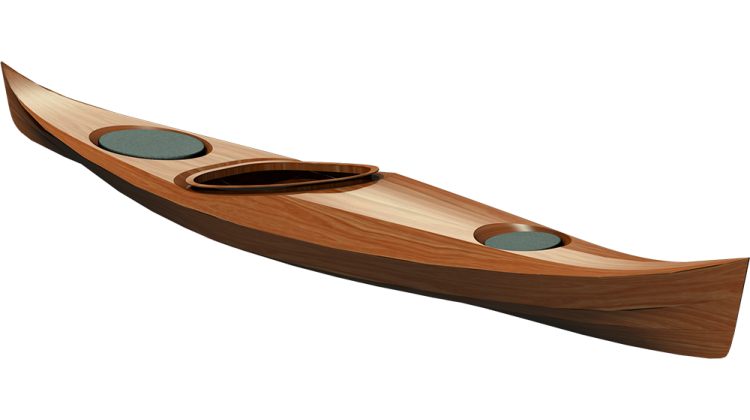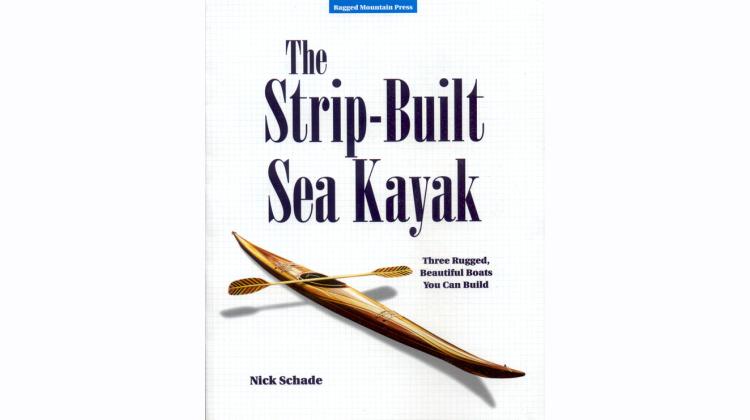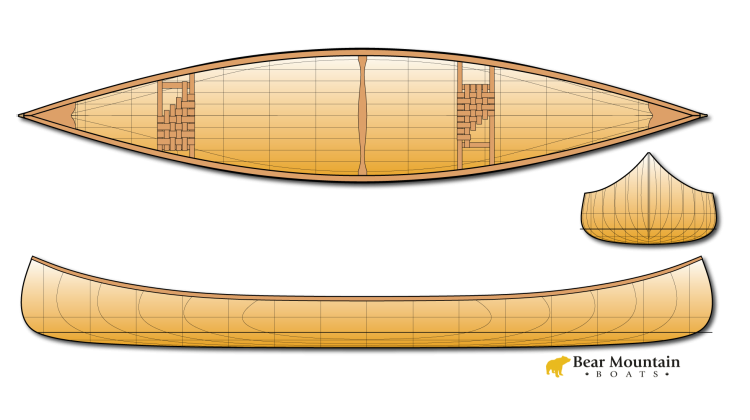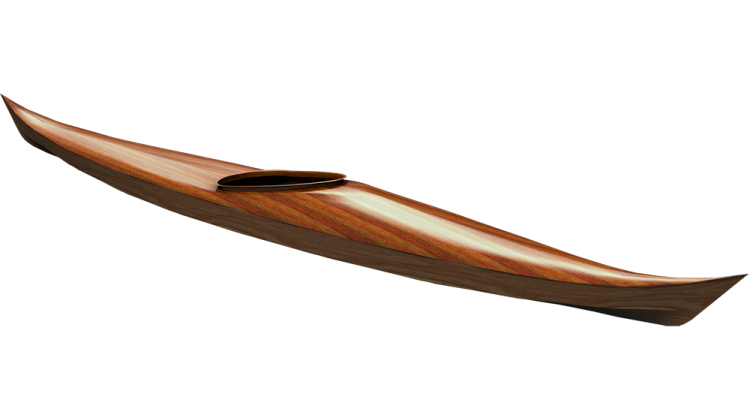"Pity about the staple holes! Should have gone stapleless." is the comment I got a few months back when I posted the above picture. "Just as easy!" said the commenter. He missed the point
There seems to be a bit of a fetish among strip-built boat builders about staples and staples holes. Don't get me wrong, a cedar strip boat built without staples can look spectacular, but we sometimes seem to forget what we are trying to accomplish. We are building boats, the staple holes don't detract from the boat's essential boatiness. The reason we may be concerned about staples is strictly aesthetic. Aesthetics are important, aesthetics are a large part of the reason we choose to build boats. From that perspective the staple holes matter, but ...
If you are a beginner or novice boat builder, the number of aesthetic faux pas available for you to make are innumerable. Staples serve as a simple, quick and easy clamp that help you do a good job on other aspects of the project. Staple holes are a minor aspect of the overall final look of the boat. You can screw up a beautiful design with all sorts of blunders. If you don't take the time to get everything else right, nobody will be impressed by your lack of staple holes.
Staples are a reliable and straightforward means to avoid a lot of other potential blemishes. Building without staples is not hard, but it is not "Just as easy." It takes longer and requires more care. The photo above is of my Noank Pulling Boat prototype. As a prototype, I didn't want to spend the extra time needed to avoid staples on an unproven design. As such, the staples are an honest artifact of the boatbuilding process. They are like the layout lines scribed in the edge of a drawer when the furniture maker creates a dovetail. I made the choice that the visible staple holes were worth the time saved.
There are many choices that must be made that effect the appearance of the finished boat. Staples are just one of them, and in my opinion, one of the least important. Decisions about, and implementation of: wood selection, edge style, stripping pattern, strip fitting, joint style, fairing, sanding, glassing, fill coats, sanding, and varnish are just some of the places where you can make more of a difference than the presence of absence of small staple holes. Insufficient care in any of these activities will create more displeasing flaws than a rows of holes.
Doing all these things well requires practice. It is unlikely you will do a perfect job on all of them your first time building a boat. You will get better as you go, but it pays off to keep things simple at first.
Wood Selection
Nobody will notice staple holes if the wood looks bad. Wood is inherently pretty. It is hard to go wrong, but some boards are stained or blotchy, have boring color or distracting grain. Your first step towards a beautiful boat is at the lumber yard, picking your boards. Think about how you will use the resulting strips and how they will effect the look of your project. What colors of wood are you finding and where might you place different colors on the boat.
Strips of wood make stripes. Many people seem to fall in love with the stripes, but over done they can be distracting. One bold stripe will often be more visually appealing than a series of alternating colors. A few subtle pin-stripes will do more to highlight the shape of the boat than a hodge-podge of racing stripes spread all over the surface. When you are learning to build, a simple stripping pattern that highlights a basic design feature of your boat will be more effective than attempting to achieve a tour-de-force master work of virtuoso pattern stripping. Just because you saw someone else do something really complicated doesn't mean you should or that it will look better than simplicity.
In my photo above, I chose two basic wood colors, light and dark. I kept the pattern simple, a light section and a dark section and then added a light pin-stripe and a dark pin-stripe. The light wood all matches and the dark wood matches. Nothing particularly fancy as it is just a prototype.
Every complications adds another opportunity to make a glaring mistake. A well laid strip with tight joints following the shape of the boat will look better than a bold pattern with poorly laid out edges or fill strips that run at odd angles. Once you choose something complicated, one misplaced strip can throw off the whole pattern and the result will look worse than a row of staple holes.
Cove and Bead vs Beveled Edges
Sloppy seams between strips with gaps or glue showing are common and distracting. Improper fitting of strips can cause distortion and potential weaknesses in the structure. Cove and bead strips provide quick alignment but can make truly tight seams difficult to achieve. Beveling the edges for a tight seam between every strip will assure a good structure and visually clean construction, but with more work. If you aren't willing to put in the effort to eliminate gaps and weak seams, there is no point in avoiding staple holes.
In the photo above, I wanted to work fast, so I used cove and bead strips. The shape of the boat is simple so there is little downside to using C&B, but some of the seams between strips show a little glue, but nothing too bad.
Fairing and Sanding
If you stand back from a varnished boat you will see reflections in the finish. On a smooth and fair boat these reflections will also be smooth and fair. Any wobble in the surface creates a distracting wiggle in the reflection. A fair surface starts by laying down fair and smooth strips. From there you may use scrapers, planes and sanding to remove any imperfections. Further sanding will produce a smooth and unblemished surface on the wood. Sufficient care to fully sand out scratches from the previous grit will minimize visual sanding swirls.
Non-fair surfaces will show from a distance and are one of the most visible aspects of the boat after the wood choices. If you can't get a fair surface don't worry about staples. Sanding swirls are only visible close up but can cover the whole boat.
In the photo above you can see a nice straight line reflection of the overhead flourescent light.
Fiberglassing
After all the work of getting a good looking wood surface with or without staples, you want it to show clearly through the fiberglass. Applying a smooth, clear, strong layer of fiberglass and epoxy is the key to sucessful strip-building. Going cheap on the epoxy and fiberglass often results in a finish that obscures the wood instead of enhancing it. Some epoxies are not intended to be used as clear coatings, use one that is. Amine blush within the cured epoxy matrix can be cloudy.
Fiberglass cloth has a "sizing" applied to the fabric that promotes proper saturation by the epoxy. With the wrong sizing or old cloth where the sizing has broken down the epoxy may not fully wet out the cloth resulting in clouded spots in the fabric. There is no point in eliminating staple holes if you can't see them through the epoxy.
Fill Coats and Sanding
Some people seem scared to get the surface of the their boat smooth. If you don't fill the weave of the cloth with epoxy, you will never achieve a smooth surface and from a distance, a rough surface will not reflect well. Even with a completely dust free coat of varnish, the rough surface will look dull and lifeless.
The secret is simple, fill the fabric weave texture with epoxy and then sand it smooth. If you start sanding into the glass before it is smooth, add more epoxy and sand again. If, when you think you are done sanding, there are still shiny spots, the surface is not smooth. A well sanded boat with enough fill coats will have a uniformly dull, matte surface when you are finished with sanding to 220 grit. If you can't get a smooth surface, don't worry about staple marks.
Varnishing
A good coat of varnish is almost wholly dependent of doing everything mentioned before this well, but sloppy brush work can still make staple holes insignificant. The photo above has one coat of varnish applied. There are some small distortions around the reflection of the light, but with a few more coats it will smooth to a mirror-like finish. Learning how to apply a smooth coat of varnish takes time and practice. Nobody gets it right the first time they try. With four or five coats applied to a boat you have a chance to practice, excellent result will require a few boats to hone your skills.
Putting it all Together
Like varnishing, all the above tasks are more easily done with practice. Getting a little bit better at each of them will pay off in the appearance of the final boat. There are a lot of skills you need to get under your belt to make you boat look its best. Eliminating staples may be one of them, but it is way down the list. Until you get good at choosing wood, laying out a nice pattern, fitting strips tight, smooth and fair, sanding a good surface, wetting out fiberglass and applying varnish, you probably don't need to worry about small holes. To the extent eliminating staple holes distracts you from doing everything else well the added effort and time in doing so just isn't worth it.
A while ago I met a builder who had made one of my Expedition Single designs. He was very proud of his boat. He was quick to point out how he didn't use staples. He also talked about how varnish was unnecessary. Honestly, it was one of the ugliest boats I had ever seen. Because he had not used varnish the sun had burned off his epoxy on large areas of the boat. The fiberglass cloth was clearly visible and in places completely worn away so the wood was exposed to the weather and subsequently turning black. I'm sure he saved a lot of time by not bothering with varnish, I hope it made up for the time he spent avoiding staples, but I am certain it was not worth it.
Once you get to the point in your skills that you really can't get much better with the other things, that is the time to start thinking about details like staple holes. And at that point you need to decide what you are trying to accomplish. For my Noank Pulling Boat prototype, I didn't want to add more time to the project than necessary, staples were a convenient time saver with little aesthetic downside. When I have the time to spend on a more flawless build, I don't use staples.






